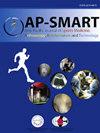Hyperuricemia predicts adverse clinical outcomes after arthroscopic microfracture of osteochondral lesions of the talus
IF 1.4
Q3 ORTHOPEDICS
Asia-Pacific Journal of Sport Medicine Arthroscopy Rehabilitation and Technology
Pub Date : 2025-06-25
DOI:10.1016/j.asmart.2025.04.004
引用次数: 0
Abstract
Purpose
To investigate the correlation of serum uric acid levels with the clinical outcomes of arthroscopic microfracture in osteochondral lesions of the talus (OLTs) and determine the cut-off point for predicting outcomes.
Methods
A total of 134 OLTs patients who underwent arthroscopic microfracture from November 2008 to June 2019 were included: 42 in the hyperuricemia group (≥ 420 μmol/L) and 92 in the non-hyperuricemia group (< 420 μmol/L). Clinical characteristics recorded and analyzed included Visual Analog Scale (VAS score), American Orthopaedic Foot & Ankle Society score (AOFAS), and 36-Item Short Form Health Survey score (SF-36). Logistic regression identified risk factors, and Receiver Operating Characteristic Curves (ROC) determined the serum uric acid cut-off value for predicting outcomes, which was prospectively validated.
Results
Significant improvement were observed in postoperative range of motion score, VAS score, AOFAS score, and SF-36 score across all patients (P < 0.05). However, the VAS score for the non-hyperuricemia group was lower; In contrast, the AOFAS and SF-36 scores were higher than the hyperuricemia group during the last visit (P < 0.05). Multivariate analysis identified age, serum uric acid, osteochondral defect size, and urate deposition as independent risk factors for clinical outcomes, and the cut-off value for the serum uric acid American Orthopaedic Foot & Ankle Society score 445 μmol/L with sensitivity and specificity of 87.25 % and 81.25 %, respectively. Additionally, the derivation set demonstrated a sensitivity of 85.71 % and specificity of 83.33 % in predicting poor outcomes.
Conclusion
Hyperuricemia predicts adverse clinical outcomes after arthroscopic microfracture of osteochondral lesions of the talus, strict postoperative drop uric acid treatment, especially hyperuricemia OLTs serum uric acid levels ≥ 445μmol/L.
Level of evidence
Level IV, case series.
高尿酸血症预测关节镜下距骨软骨病变微骨折后的不良临床结果
目的探讨血清尿酸水平与关节镜下距骨软骨病变(OLTs)微骨折临床预后的相关性,并确定预测预后的截断点。方法收集2008年11月至2019年6月接受关节镜微骨折治疗的OLTs患者134例:高尿酸血症组42例(≥420 μmol/L),非高尿酸血症组92例(<;420μmol / L)。记录和分析临床特征包括视觉模拟量表(VAS)、American Orthopaedic Foot;踝关节社会评分(AOFAS)和36项简短健康调查评分(SF-36)。Logistic回归确定了危险因素,受试者工作特征曲线(ROC)确定了预测预后的血清尿酸临界值,并对其进行了前瞻性验证。结果所有患者术后活动范围评分、VAS评分、AOFAS评分和SF-36评分均有显著改善(P <;0.05)。然而,非高尿酸血症组VAS评分较低;相比之下,AOFAS和SF-36评分在最后一次访问时高于高尿酸血症组(P <;0.05)。多因素分析发现,年龄、血清尿酸、骨软骨缺损大小和尿酸沉积是影响临床结果的独立危险因素,血清尿酸的临界值为美国骨科足;踝关节社会评分为445 μmol/L,敏感性87.25%,特异性81.25%。此外,衍生集在预测不良预后方面的敏感性为85.71%,特异性为83.33%。结论高尿酸血症预示着关节镜下距骨软骨病变微骨折后的不良临床结局,术后应严格降尿酸治疗,尤其是高尿酸血症患者血清尿酸水平≥445μmol/L。证据等级:IV级,案例系列。
本文章由计算机程序翻译,如有差异,请以英文原文为准。
求助全文
约1分钟内获得全文
求助全文
来源期刊
CiteScore
3.80
自引率
0.00%
发文量
21
审稿时长
98 days
期刊介绍:
The Asia-Pacific Journal of Sports Medicine, Arthroscopy, Rehabilitation and Technology (AP-SMART) is the official peer-reviewed, open access journal of the Asia-Pacific Knee, Arthroscopy and Sports Medicine Society (APKASS) and the Japanese Orthopaedic Society of Knee, Arthroscopy and Sports Medicine (JOSKAS). It is published quarterly, in January, April, July and October, by Elsevier. The mission of AP-SMART is to inspire clinicians, practitioners, scientists and engineers to work towards a common goal to improve quality of life in the international community. The Journal publishes original research, reviews, editorials, perspectives, and letters to the Editor. Multidisciplinary research with collaboration amongst clinicians and scientists from different disciplines will be the trend in the coming decades. AP-SMART provides a platform for the exchange of new clinical and scientific information in the most precise and expeditious way to achieve timely dissemination of information and cross-fertilization of ideas.

 求助内容:
求助内容: 应助结果提醒方式:
应助结果提醒方式:


